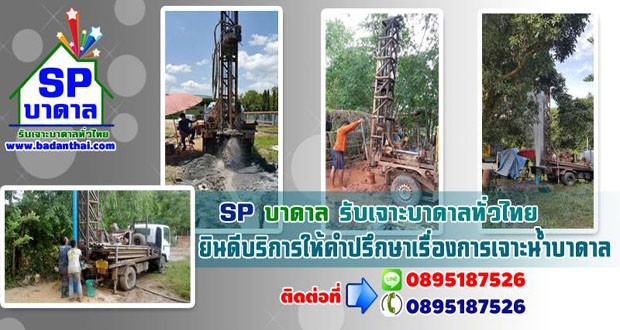
การก่อสร้างบ่อ
การก่อสร้างบ่อ(Well Completion)
การทำรูเจาะ ( Hole ) ให้เป็นบ่อน้ำ ( Water Well ) พร้อมที่จะพัฒนาเอาน้ำขึ้นมาใช้ได้ เรียกว่าการทำบ่อ ( Well Completion ) ซึ่งประกอบด้วยการออกแบบบ่อ ( Well Design ) การใส่ท่อกรุท่อกรอง และการกรุกรวด ( Gravel Packing)
1.การออกแบบบ่อ
1. คว้านบ่อด้วยหัวเจาะ 15 นิ้ว เพื่อใส่ท่อกรุและท่อกรองขนาด 8 นิ้ว
2. คว้านบ่อลงไปจนถึง 350 ฟุต ละปล่อยให้เศษดินลักรวดทรายลงไปถมถึง 900 ฟุต หากไม่เต็มก็ต้องหาดินหรือทรายจาก
ภายนอกใส่เพิ่มเข้าไปจนเต็มถึงระดับ 350 ฟุต
3. อุดซีเมนต์ในบ่อที่คว้านขนาด 15 นิ้วนี้แล้ว จาก 295 ฟุต ไปจนถึง 350 ฟุต เพื่อไม่ให้น้ำ เค็ม ชั้นล่างเข้ามาปนน้ำจืด
(ระยะจาก 295-307 ฟุต ซึ่งเป็นชั้นน้ำจืดนั้นอุดซีเมนต์ไว้ด้วย เพื่อให้การอุดมีประสิทธิภาพดียิ่งขึ้น)
4. ใส่ท่อกรุขนาด 8 นิ้ว จากผิวดินลงไปจนถึงความลึก 270 ฟุต จาก 270-290 ฟุต ใส่ท่อกรองขนาดเดียวกัน โดยใช้ท่อ
กรองขนาดช่องว่าง 50/1000 นิ้ว จากระดับ 290-295 ฟุต อันเป็นระดับซีเมนต์ก้นบ่อ ใส่ท่อกรุอีกท่อนหนึ่งขนาดเดียว
กัน ปลายท่อกรุล่างสุดปิด
5. ใส่กรวดคัดขนาด 1/8 – 1/4 นิ้ว รอบๆ ท่อกรองและท่อกรุ จากระดับ 265-295 ฟุต
6. ช่องว่างระหว่างท่อกรุกับผนังบ่อ ตั้งแต่ผิวดินจนถึง 265 ฟุต อุดไว้ด้วยซีเมนต์อีกครั้งเพื่อกันน้ำเค็มตอนบนลงไปปนน้ำจืด
7. ซีเมนต์ที่ใช้ทั้งหมดคำนวณได้ 18 ตัน ผลการทำบ่อนี้ ปรากฏว่า เมื่อพัฒนาบ่อเสร็จแล้ว ได้น้ำจืดตามความประสงค์
2. การใส่ท่อกรุท่อกรอง
ท่อกรุเป็นเหล็กเหนียวใช้ใส่ในบ่อเพื่อเป็นผนังถาวรของบ่อ และเป็นเรือนรับหัวดูดของเครื่องสูบน้ำบาดาลด้วย บ่อทุกบ่อที่จะเจาะในหินร่วนต้องใส่ท่อกรุเพื่อกันไม่ให้บ่อพัง บ่อเจาะในหินแข็งซึ่งเมื่อถูกน้ำแช่นาน จะแตกเปื่อยยุ่ย เช่นหินดินดานก็ต้องใส่ท่อกรุด้วย ส่วนบ่อที่เจาะในหินแข็งซึ่งสามารถจะทรงตัวอยู่ได้ไม่ว่าจะมีน้ำหรือไม่มี ก็ไม่จำเป็นต้องใส่ บ่อที่ไม่ใส่ท่อกรุเรียกว่า บ่อเปิด ( Open Hole )
3. การกรุกรวด(Gravel Packing)
4. การพัฒนาบ่อ
Well Completion
Making a hole (Hole) into a well (Water Well) ready to develop water to use. Called to make a well (Well Completion), which consists of the design of the well (Well Design) to insert the filter pipe. And gravel (Gravel Packing)
1. Design of the pond
1. Boring the well with a 15-inch drill bit to insert the 8-inch pipe and filter pipe.
2. Dig the pit down to 350 feet and allow 900 feet of gravel and sand to fill up. If it is not full, find soil or sand
The exterior is added until it reaches a level of 350 feet.
3. Fill the cement in this 15 inch cored well from 295 ft. to 350 ft. to prevent saltwater from entering the ground floor into the fresh water.
(The distance from 295-307 feet, which is the freshwater layer, is filled with cement. To make the filling more effective)
4. Insert the 8-inch pipe from the soil surface down to a depth of 270 feet from 270-290 feet. Put the filter pipe of the same size using the pipe.
Filter the gap size 50/1000 inches from the level of 290-295 feet, which is the level of cement at the bottom of the well. Insert another piece of pipe of the same size.
Together, the end of the pipe at the bottom is closed.
5. Put 1/8 - 1/4 inch grit around the filter pipe and the casing from 265-295 feet.
6. The gap between the pipe and the wall of the well From the surface of the soil to 265 feet, again covered with cement to waterproof the upper salinity into fresh water.
7. The total cement used was calculated at 18 tons. The result of making this well appeared when the development of the well was completed. Get fresh water on demand
2. Inserting the filter pipe
The casing is made of ductile iron to be put in the pond as a permanent wall of the pond. And is also a housing for the suction nozzle of the groundwater pump All wells to be drilled in loose rock must be lined with casing to prevent the well from collapsing. Wells drilled in hard rock which, when exposed to water for a long time will crumble For example, shale must also be lined with pipes. Wells drilled in hard rock which can be stabilized with or without water. It is not necessary to put A well that does not have a casing is called an open pit.
3. Gravel Packing
4. Pond development
5. Water content test
完井
在井(Water Well)中打一个洞(Hole),准备开发水使用。称为造井(Well Completion),它由设计井(Well Design)插入过滤管组成。和砾石(Gravel Packing)
1. 池塘的设计
1、用15英寸钻头钻孔,插入8英寸管子和过滤管。
2. 将坑挖到 350 英尺,并让 900 英尺的砾石和沙子填满。如果没有满,找土或沙子
添加外部直到它达到 350 英尺的高度。
3. 在这个 15 英寸有芯井中从 295 英尺到 350 英尺填充水泥,以防止盐水进入底层进入淡水。
(295-307英尺的距离,即淡水层,用水泥填充。为了使填充更有效)
4. 将 8 英寸的管子从土壤表面插入 270-290 英尺深至 270 英尺的深度。使用管道放置相同尺寸的过滤器管道。
从 290-295 英尺的水平面过滤 50/1000 英寸的间隙,这是井底水泥的水平面。插入另一根相同尺寸的管子。
一起,底部的管道末端是封闭的。
5. 在过滤器管和套管周围放置 1/8 - 1/4 英寸的砂砾,距离 265-295 英尺。
6. 管子与井壁之间的缝隙 从土壤表面到 265 英尺,再次用水泥覆盖,将上层盐分防水到淡水中。
7、水泥用量按18吨计算。这口井的开发完成时,就出现了打井的结果。按需获取淡水
2. 插入过滤管
外壳由球墨铸铁制成,放置在池塘中作为池塘的永久壁。并且也是地下水泵吸嘴的外壳 所有在松散岩石中钻探的井都必须衬有套管,以防止井塌。在坚硬的岩石中钻出的井,当长时间暴露在水中时会崩溃。例如,页岩也必须衬有管道。在硬岩中钻探的井,可以在有水或没有水的情况下稳定。没有必要放 没有套管的井称为露天井。
3. 砾石包装
4. 池塘开发
5. 含水量测试



